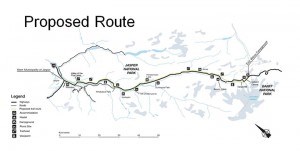
Over the coming weeks the 51°ĩÍø will be publishing a series of stories related to the proposed Icefields Trail project after it obtained a dossier of internal documents between Parks Canada staff released under Freedom of Information legislation.
The origin of the Icefields Trail project has remained shrouded in mystery since it was quietly announced in the federal budget in March 2016, but a secret memo obtained by the 51°ĩÍø reveals Parks Canada started talking about the idea in December 2014.
According to a memo labelled "secret" to the minister of the environment and climate change, executives with the mountain parks discussed the concept of constructing a 230-kilometre trail that would link Jasper to Lake Louise in December 2014. The memo was stamped June 30, 2016.
It stated the estimated cost to complete the project at that time was $160 million over five years according to an assessment conducted by an independent engineering consulting company. The cost estimate was further informed by work undertaken to build the Legacy Trail in Banff National Park.
The trail was initially shelved because there was no funding available at the time, however in February 2016, Parks Canada revisited the project after a request from the Department of Finance for infrastructure proposals that could be completed within two years.
âGiven the two-year constraint Parks Canada submitted a proposal with a reduced scope of work from that which was envisioned in the 2014 proposal,â the memo states.
The 2016 budget allocated $65.9 million for the 109-km trail from Jasper to the Columbia Icefields Discovery Centre over two years with Parks Canada chipping in another $20.5 million to complete the project during the third and final year for a total of $86.4 million.
According to the memo, the $65.9 million included money for an environmental assessment and design work for the 123-km segment from the Discovery Centre to Lake Louise, but due to time constraints and construction costs no money was allocated to build it.
A briefing note from April 2016 shows construction of the trail was originally slated to begin in early 2017 with the trail completed by the fall of 2018. By the end of June the schedule was revised with a targeted completion of March 2019, according to a memo signed by Daniel Watson, the chief executive officer of Parks Canada.
The documents that reveal this timeline were among more than 500 pages of emails, memorandums to the minister and draft communication strategies, that were obtained under Freedom of Information legislation by researcher Ken Rubin and provided to the 51°ĩÍø through a third party. Parks Canada failed to provide a comment before press deadline.
The new information follows a federal report by the standing committee of the environment and sustainable development, which recently found it was difficult to understand the decision-making process for development projects in Canadaâs national parks.
âWhile there will always be people who disagree with some development decisions, the committee itself discovered that it is difficult to understand the decision-making process,â the report stated.
âFor example, despite repeated questions to numerous witnesses, the committee was unable to determine what process led up to the announcement in budget 2016 of a $65.9 million investment for a new biking and walking trail in Jasper National Park. More transparency in decision making is required.â
Wayne Stetski, the NDPâs Parks Canada critic, said this was the first time he had heard anything about the origins of the project.
âThatâs news to me,â Stetski said, who worked with the committee.
âWe asked several people at various levels in Parks Canada if they could tell us where that came from in terms of pointing to a document, preferably a public document, that had been vetted, that had an environmental impact assessment done, that had community consultations done and there was nothing that we could find anywhere.â
Alison Woodley, national director for Canadian Parks and Wilderness Society (CPAWS), said the documents show a lack of transparency.
âClearly there was a whole lot of planning going on behind closed doors,â said Woodley.
âThe process that has unfolded to date is completely out of line with transparency, with the mandate and with the responsibility to manage our parks on behalf of Canadians.â
According to Parks Canada, the idea of the Icefields Trail project is based on the 2009 Icefields Strategic Concept, which briefly states the need to âdevelopâ and âexploreâ options to enhance cyclistsâ needs. Parks Canada has also said the project is part of the management plans for both Jasper and Banff National Parks.
Woodley described Parks Canadaâs defense of the trail as âmisleading.â
âThis is not in the management plan, regardless of what Parks Canada has said to the contrary, which I find to be misleading, this is not in the Jasper park management plan.â
She said the proposed project should have been made public before it was included in the 2016 budget.
âFrom reading the document it seems like once the money was announced in the budget it became more about spending the money than about the park.â
âThe good news is that Parks Canada is now saying that itâs not a done deal and that seems to be a change from what shows up in those documents, which is a positive change, so thereâs still an opportunity to reconsider this.â
Paul Clarke
[email protected]
